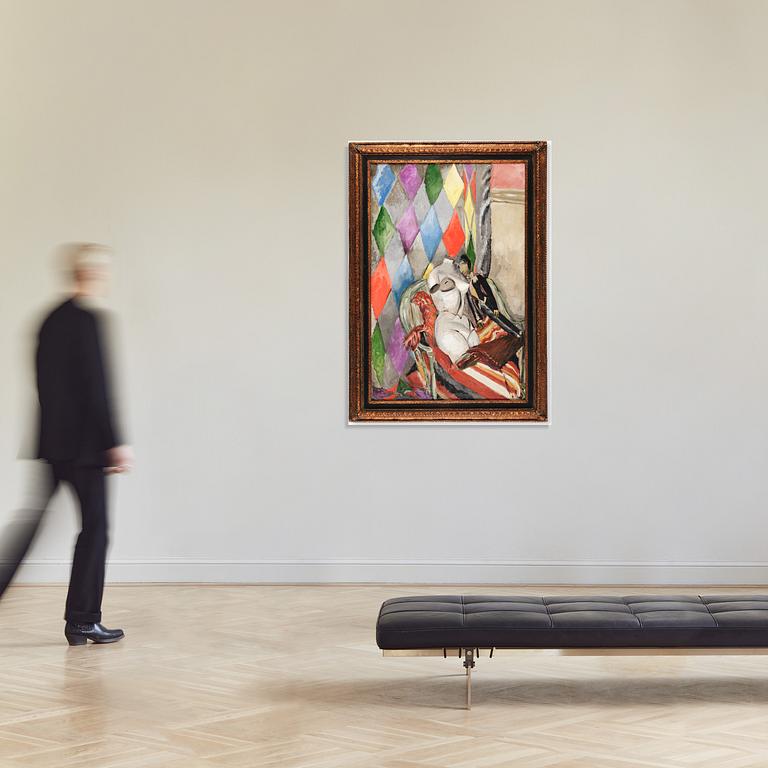Sigrid Hjertén
"Harlekin"
Executed in 1928. Canvas 130.5 x 85.5 cm.
Exhibitions
Konstakademien, Stockholm, "Sigrid Hjertén oljemålningar och gouacher 1911 - 1936", April 1936, cat. no 143.
Nationalmuseum, Stockholm, 1949.
Liljevalchs konsthall, "Sigrid Hjertén", Stockholm, 17 March - 28 May 1995.
Traveling exhibition Münich, Berlin, Borås, 1999 - 2000, "Sigrid Hjertén - Pioneer of Swedish Expressionism", cat. no 59.
Prins Eugens Waldemarsudde, Stockholm, "Sigrid Hjertén - En mästerlig kolorist", 10 February - 19 August, 2018, cat. nr 67.
Literature
Carl Palme, "Sigrid Hjertén", 1936, listed on page 38 under the year 1928.
Liljevalchs exhibition catalogue, 1995, depicted in full color on page 60.
Katarina Borgh Bertorp ed. Sigrid Hjertén - Pioneer of Swedish Expressionism", exhibition catalog for the traveling exhibition in Munich, Berlin, Borås, 1999-2000, cat. no. 59, depicted and mentioned.
Görel Cavalli-Björkman, "Woman in the Avant-Garde, Sigrid Hjertén. Life and Work", 2017, mentioned on pages 224-225, depicted on page 226.
Prins Eugens Waldemarsudde, Stockholm, "Sigrid Hjertén - En mästerlig kolorist", February 10 - August 19, 2018, cat. no. 67. Depicted in full color on a page in the exhibition catalog and mentioned on page 25.
More information
Görel Cavalli-Björkman writes about Sigrid's painting in the 1920s and about Harlekin: "The paintings become more intimate and provide a deeper interpretation of reality. The importance of colour is still highlighted in the painting Harlekin, a still life where Sigrid has draped a romb-patterned curtain over the back of a chair and placed a doll representing Isaac leaning against an antique female torso. The Isaac doll, as well as a companion doll depicting Sigrid, were already in the artist's home. These dolls were made by fellow artist Marie Vasilieff.
The art world Sigrid had encountered on her return to Paris was quite different from that of her school years. There was now a general desire to break away from pre-war expressionism and return to figurative art. The literary subjects of academic painting had been completely abandoned by the avant-garde. During the interwar period, the Italian commedia dell'arte was rediscovered. It became a kind of alternative, a modern mythology with its different types of picturesque characters and masks. Picasso, more than any other artist, came to devote himself to this circle of motifs. He had studied Neapolitan Street theatre and used its characters in his costumes and set design for Jean Cocteau's production of Parade for the Russian Ballet. The Harlequin figure became his alter ego throughout his life, dominating his sketchbooks from 1915-16.
Sigrid's choice of the Harlequin motif in the painting “Harlekin” shows that she was aware of the importance of Commedia dell'arte at the time. She connects to it with the Isaac doll and the chequered drapery, which she jokingly refers to as the 'Kipasso dress'. Its romb-pattern in blue and red is traditionally found in the Harlequin's costume. As well as the painting “Harleking” makes a general reference to Picasso, Sigrid takes the opportunity to tease her own Harlequin, who constantly seeks comfort at the breast of Venus. She had previously painted the pair of Harlequin and Columbine, perhaps as a portrait pair alluding to herself and Isaac" (Prins Eugens Waldemarsudde, Stockholm, "Sigrid Hjertén - En mästerlig kolorist", page 25).




































































